
Topics
Guests
- John Pirozzidirector of Don’t Think I’ve Forgotten.
- Kagnol Molthe guitarist and founding member of Cambodia’s first surf guitar band, Baksey Cham Krong. At least 20 members of his family died under the Khmer Rouge.
- LinDa Saphanassociate producer and principal researcher for Don’t Think I’ve Forgotten.
As the 40th anniversary of the end of the Vietnam War approaches we look at the impact of the murderous regime in power in neighboring Cambodia. The secret U.S. carpet bombing of Cambodia that began in 1969 killed as many as 500,000 civilians and contributed to the rise of the Khmer Rouge. When the U.S. evacuated its troops during the fall of Saigon on April 30, 1975, it came shortly after it had also withdrawn its diplomatic staff in Phnom Penh in Cambodia. On April 17, 1975, the Khmer Rouge marched into the capital city and began a forced evacuation. Over the next four years it oversaw the death of nearly two million Cambodians by starvation, torture and execution. It focused especially on drawing out Western influences, targeting artists, intellectuals and musicians. Now a new film uncovers the lost history of Cambodia’s rock 'n' roll musicians in the pre-Khmer Rouge era. It is called “Don’t Think I’ve Forgotten.”
In this extended interview, we feature excerpts from the film and speak with director John Pirozzi and Mol Kagnol, the guitarist and founding member of Cambodia’s first surf guitar band, Baksey Cham Krong. He lost 20 members of his family under the Khmer Rouge. We also speak with Dr. LinDa Saphan, associate producer of the documentary, who lived in Phnom Penh in 1975 and was forced to evacuate along with her family.
Today, many of the musicians who survived the Khmer Rouge and are featured in the film will be reunited for two historic concerts at the City Winery.
“Don’t Think I’ve Forgotten: Cambodia’s Lost Rock and Roll” is now playing in New York City at Film Forum and is set to tour the United States.
See more coverage by Democracy Now! of the U.S. war in Vietnam and Cambodia.
For more details, see the film’s website.
Transcript
AMY GOODMAN: This is Democracy Now!, democracynow.org, The War and Peace Report. I’m Amy Goodman. As the 40th anniversary of the end of the Vietnam War approaches, we look at a new film about the impact of the murderous regime in power in neighboring Cambodia. The secret U.S. carpet bombing of Cambodia that began in 1969 killed as many as half a million civilians—that’s right, 500,000 civilians—and contributed to the rise of the Khmer Rouge. When the U.S. evacuated its troops during the fall of Saigon on April 30th, 1975, it came shortly after it had also withdrawn its diplomatic staff from Phnom Penh in Cambodia. On April 17, 1975, the Khmer Rouge marched into the capital city and began a forced evacuation. Over the next three years, eight months and 20 days, it oversaw the death of nearly two million Cambodians by starvation, torture and execution. It focused especially on drowning out Western influences, targeting intellectuals, artists and musicians.
Now a new film opening here in New York uncovers the lost history of Cambodia’s rock 'n' roll musicians in the pre-Khmer Rouge era. It’s called Don’t Think I’ve Forgotten.
SAM ANG SAM: There is a saying in Cambodia: Music is the soul of a nation.
PRINCE PANARA SIRIVUDH: [translated] Phnom Penh was called “The Pearl of South East Asia.” It was the hub where bands from the countryside met.
SAMLEY HONG: [translated] We introduced all kinds of modern music here.
THIDA BUTH: I was not a shy kid, you know. I was like, “Just give me the music. I’ll dance.”
TOUCH CHHATTHA: [translated] We were like hippies, having fun.
THIDA BUTH: I’m like, this is so cool. It’s my generation. I was ready for more. And all of a sudden, it’s all gone.
JOHN GUNTHER DEAN: We did get involved in bombing a neutral country.
DAVID CHANDLER: The Khmer Rouge came in as enemies to an enemy city. The new Cambodia was going to be a revolutionary country and not contaminated by the West.
SIENG VANTHY: [translated] I told them I was a banana seller. I was a singer. I lied to them. That saved my life.
PRINCE NORODOM SIRIVUDH: [translated] If you want to eliminate values from past societies, you have to eliminate the artists, because artists are influential. Artists are close to the people.
AMY GOODMAN: Don’t Think I’ve Forgotten. That’s the trailer for this new film. It opens in New York this week, Friday. Many of the musicians who survived the Khmer Rouge are featured in the film, will be reunited for two historic concerts at the City Winery.
Well, for more, we’re joined right now by John Pirozzi, director of Don’t Think I’ve Forgotten, and Dr. LinDa Saphan, its associate producer. And we’re joined by Mol Kagnol, who was the guitarist and founding member of Cambodia’s first surf guitar band, Baksey Cham Krong, in the 1960s. At least 20 member of his family died under the Khmer Rouge regime that followed. His story is told in this film, Don’t Think I’ve Forgotten. He’ll be performing on Friday.
We welcome you all to Democracy Now! John Pirozzi, let’s start with you. Why did you make this film?
JOHN PIROZZI: You know, I first went to Cambodia in 2001 to work with Matt Dillon on his film, City of Ghosts, and I was really taken by Phnom Penh. And you could see that there had been a modern city there. When we were there in 2001, it was very different. It was still recovering from what it had gone through. And so, I was just curious to know what had existed before the Khmer Rouge, and I tried to find out, and there was very little information. There was certainly very little visual representation of what had existed. So, I started to read as much as I could about the history of modern Cambodia, but it wasn’t until I came back here to New York and heard the music—actually, someone sent me a compilation called Cambodia Rocks, which came out in 1996—that I really heard the music. And once I heard the music, I was like, “Well, how is this possible? What is this music? Who are the people that created it?” And there was no information available that I could find. So, in some ways, it was really my own personal, you know—so, in some ways, I really wanted to find out for myself who the people were that made the music, where the music originated from. And I started to make the film.
AMY GOODMAN: The musicians, how did you find them?
JOHN PIROZZI: I started to shoot the film in 2003. I was in Los Angeles at the time. And Long Beach, California, has the largest population of Cambodians outside of Cambodia, and it’s very close to Los Angeles. So I went down to L.A. and just started talking to people. And there were actually some surviving musicians living in Long Beach. And then, eventually, I was able to get back to Cambodia and began working with an organization called the Documentation Center of Cambodia. They single-handedly have tried to piece together the history of what’s happened under the Khmer Rouge. And their director, Youk Chhang, really helped us find surviving musicians. His network of people really is extensive throughout the country. And actually, now with the trials that are happening in Phnom Penh, Youk Chhang has provided much of the evidence in the Khmer Rouge trials that are happening now.
AMY GOODMAN: In this clip in your film, Don’t Think I’ve Forgotten, we hear from Prince Norodom Sirivudh, whose half-brother, Prince Norodom Sihanouk, was deposed when the Khmer Rouge seized control of Cambodia.
PRINCE NORODOM SIRIVUDH: [translated] I grew up in the 1950s, when Cambodia was prosperous in culture, art and music, in particular. I stress that because our royal government in the ’50s had a policy to encourage music.
PRINCE NORODOM SIHANOUK: [translated] I belong to a family that loves the arts. My father was a musician. He was a saxophonist and flutist.
AMY GOODMAN: Now, that last voice was Prince Norodom Sihanouk, who played a key role in joining with the Khmer Rouge right before they took over. He’s talking about the importance of music.
JOHN PIROZZI: Yeah, you know, the royal family has a long tradition of being patrons of the arts. And beyond being just patrons, they were also artists themselves. And certainly Norodom Sihanouk, I think, paved the way for a lot of younger Cambodians to create music, to create art, because he made it accessible, and he also made it, you know, OK to do it. I mean, you know, as if the king is doing it, then I guess it’s OK for me to do it, is what a lot of people told us.
AMY GOODMAN: Talk about the title, Don’t Think I’ve Forgotten.
JOHN PIROZZI: There’s a song by essentially the greatest pop star of the period, was Sinn Sisamouth, and there’s a song called Don’t Think I’ve Forgotten. So, when I heard that song and had it translated, it seemed to fit perfectly for what the title of the film should be. But in the song, he talks about, you know, I’ll never forget our love, I’ll never forget the time we shared together. But he also at one point says, “Even when I’m dead and gone, I’ll still remember our love.” So it’s very prescient in a lot of ways, obviously. And that’s—yeah, that’s where we pulled the title from.
AMY GOODMAN: Let’s go to a little of that song, “Don’t Think I’ve Forgotten.”
[Sinn Sisamouth’s “Don’t Think I’ve Forgotten”]
AMY GOODMAN: “Don’t Think I’ve Forgotten” is played by Sinn Sisamouth, who is one of the main musicians of Cambodia.
JOHN PIROZZI: Sinn Sisamouth was the biggest pop star, and he had an incredible ability to adapt to every style that was coming out at the time. He started out as a crooner in the '50s. He adapted to rock ’n' roll very easily. And all the way up until the Khmer Rouge takeover, he was still creating new music that was—you know, that was up-to-date. And today, he’s still the biggest star. And when you go to Cambodia now, you hear his music everywhere.
AMY GOODMAN: LinDa Saphan, if you could elaborate on this?
LINDA SAPHAN: For the music in Cambodia, music is really part of the culture. From wedding ceremony to funerals, it is really a ritual that is, I guess, the soul of the nation’s culture. So, the royal family has to be embodying, representing certain music, like court music, ballet, all this. So a lot of, for example, classical ballet dancing was only trained and practiced at the palace, and the queen was the teacher. Only under Lon Nol regime that the ballet was taught at the university. So, there’s certain element of elite music was only by the court, royal court. But with Norodom Sihanouk, he tackling popular music, practicing it and making film and featuring popular musicians, really allow the younger to feel that it was tolerated, participated, even supported by the royal figure.
AMY GOODMAN: And in the film, you show people rock 'n' roll dancing. But you even see some of the hand gestures as kind of ballet.
LINDA SAPHAN: Yes, there’s a lot of the traditional dance movement, from the Romvong traditional dancing of—at any wedding celebration we do. So there’s a combination. You know, you do the cha-cha-cha, but a Khmer way cha-cha-cha. So there’s always this intertwined mixing, elaborating their own dancing and music.
AMY GOODMAN: Let’s go to another clip of Don’t Think I’ve Forgotten. This is historian David Chandler. Then we hear from Cambodia’s Prince Norodom Sihanouk.
DAVID CHANDLER: First decade of independence, '55-'65, often referred to as the Sihanouk period, was a period of relative prosperity, certainly of peace in Cambodia. It wasn’t a democratic country. There was only one person in charge, and his one-party state was brutally enforced by his police.
REPORTER: [translated] Excellency, recently 14 Communists were sentenced to death here.
PRINCE NORODOM SIHANOUK: [translated] Yes, yes.
REPORTER: [translated] Why?
PRINCE NORODOM SIHANOUK: [translated] We have a strict law against subversive activities, against treasonous activities. We have to keep our country’s peace, at any price.
AMY GOODMAN: That’s a clip from Don’t Think I’ve Forgotten, that last voice, again, Cambodia’s Prince Norodom Sihanouk. John Pirozzi, why did the Khmer Rouge want to stamp out music?
JOHN PIROZZI: I think, you know, the Khmer Rouge had this idea to take Cambodia back to when Cambodia ruled all of Southeast Asia, the Angkor period some 1,200 years ago. And when Cambodia ruled all of Southeast Asia, the way they did it was by growing three crops of rice a year instead of just one. And they had built giant irrigation projects. They had built dams and canals. So the idea was to go back to that model and do away with anything that was modern, become a completely agrarian society. So, you know, obviously anything Western was associated with anything modern at that point.
AMY GOODMAN: LinDa Saphan, introduce our next guest, his significance in Cambodian life.
LINDA SAPHAN: Mol Kagnol is the band member from the Baksey Cham Krong, which is the first surf guitar band that came together.
AMY GOODMAN: So we are joined by Mol Kagnol, who was the guitarist and founding member of Cambodia’s first surf guitar band—yes, it’s called Baksey Cham Krong—in the 1960s. At least 20 members of his family died under the Khmer Rouge regime that followed. His story is told in the film, Don’t Think I’ve Forgotten. Talk about how you got into this band in the ’60s, how you founded this band.
MOL KAGNOL: I played music, electric guitar, by accident, because one of my brothers owned the electronics shop, and one day somebody bring the amplifier and guitar for him to repair. And he just wanted me to pluck the string so he can test the amplifier. And I find out that the dot on the fingerboard is very similar to accordion. So I start from there.
JOHN PIROZZI: And how old were you then?
MOL KAGNOL: Preschool.
AMY GOODMAN: How did you start the band?
MOL KAGNOL: After school in one particular year, I just go around and looking for who else can play guitar, so we can exchange information, who know more about what. And then, you just get more and more people together, and you just want to play.
AMY GOODMAN: So, what does Baksey Cham Krong mean?
MOL KAGNOL: It’s a name of the one of those temples around the Angkor Wat region.
AMY GOODMAN: And, Mol Kagnol, for you to see this film, what has it meant to you?
MOL KAGNOL: I cannot believe that something that I innocently play and start to have interest in, in the U.S., thanks for John to bring it up.
AMY GOODMAN: And you’re going to be playing at the City Winery.
MOL KAGNOL: Yes.
AMY GOODMAN: With who?
MOL KAGNOL: With two of my band members that’s still alive and some other musicians from Cambodia that sit that place, take that place.
AMY GOODMAN: And what does that mean to you?
MOL KAGNOL: This mean a lot to me. Yeah, I already put all my guitar in the closet, and now I had to bring it back out. And—
AMY GOODMAN: Have you started practicing?
MOL KAGNOL: Yes.
AMY GOODMAN: And why did you end up coming to the United States, and when was it?
MOL KAGNOL: I think it’s January or February of 1975 for a test pilot class in the U.S.
AMY GOODMAN: You now had joined the Cambodian military backed by the United States.
MOL KAGNOL: Yes.
AMY GOODMAN: And what made you decide to do that?
MOL KAGNOL: Just exciting about the aircraft, airplane, wanted to fly the airplane.
AMY GOODMAN: So you were here when the U.S. evacuated from Phnom Penh and the Khmer Rouge took over.
MOL KAGNOL: Yes. Mm-hmm, yeah.
AMY GOODMAN: Where was your family?
MOL KAGNOL: All stayed behind in Cambodia.
AMY GOODMAN: And what happened to them?
MOL KAGNOL: I didn’t have the clear story on that, but end up with over 20 of them was—not survive.
AMY GOODMAN: Were you able, in any way, to be in touch with them after the fall of Phnom Penh?
MOL KAGNOL: No, not at all.
AMY GOODMAN: I want to go to yet another clip of Don’t Think I’ve Forgotten. This is John Gunther Dean, who was the U.S. ambassador to Cambodia at the time when Pol Pot and the Khmer Rouge seized power. In this clip, he recalls how on the morning of the evacuation of Phnom Penh, which was April 17, 1975, he received a letter from the country’s former deputy prime minister, Prince Sirik Matak, about his decision not to evacuate with help from the Americans.
JOHN GUNTHER DEAN: Sirik Matak wrote this letter on the 12th of April, 1975, delivered to me a couple of hours before the United States evacuated from Phnom Penh. “Dear Excellency and Friend: I thank you very sincerely for your offer to transport me towards freedom. I cannot, alas, leave in such a cowardly fashion. As for you, and in particular for your great country, I never believed for a moment that you would have this sentiment of abandoning a people which has chosen liberty. You have refused us your protection, and we can do nothing about it. You leave [us] and my wish is that you and your country will find happiness under the sky. But, mark it well, that if I shall die here … in my country that I love, it is too bad … I have only committed this mistake of believing in you, the Americans. Please accept, excellency [and] dear friend, my faithful and friendly sentiment.” Signed, Sirik Matak. He was killed one week later.
AMY GOODMAN: John Gunther Dean, at the time the U.S. ambassador to Cambodia, reading a letter from Cambodia’s former deputy prime minister, Prince Sirik Matak. And again, at the end of that clip, you heard John Gunther Dean say that Prince Sirik Matak was killed one week later. LinDa Saphan, you were two years old at the time of the fall of Phnom Penh, where your family and you were living?
LINDA SAPHAN: Yes. I just want to—every Cambodian who went through the Khmer Rouge, whether they were there or outside the country, our own personal biography is very complicated, to piece it together, when Kagnol said we don’t know what happened to the family. Only a year and a half ago, the government of Cambodia is now allowing to teach the history of the Khmer Rouge. Before that, no mentions of it in the history book. So, it’s really hard for our nation to understand what’s going on, who they are and what is happening. And individually, we don’t have this sense. So, to have a narrative, even my own whole personal history, it’s a bit hazy.
AMY GOODMAN: Talk about what happened to your family. April 17, 1975, the Khmer Rouge come in as the Americans leave, forcing millions of people out of Phnom Penh. Where did your family go?
LINDA SAPHAN: My family, because on my mother’s side are educated, my uncle, one of her older brother, was engineer. Him and his wife did not survive that day. Another older sister, whose jewelry business—doing jewelry store, did not survive, her and her husband, that day. So, my mother, who was a French teacher, managed to survive because she kind of grasped what’s going on, so she cut her hair, destroyed her hand, because the hands of a bourgeois is soft, and so she acted up as if she was under the shock. My father, who was an engineer also, survived because the head of the village where he grew up lied and said he was a fisherman. And we had to evacuate from Phnom Penh to go to my mother’s hometown village in Takev.
JOHN PIROZZI: I’d like to say, you know, one thing is that people didn’t understand who the Khmer Rouge were when they took over the country, and it was a shock. You know, they thought the war, the five-year civil war, was over now, and there would be peace. But quickly they realized that wasn’t going to be the case. And having to change your identity or hide your identity to survive was something they had to sort of figure out on the fly. And, you know, some people didn’t realize that. And actually, some people who were just, you know, day workers started to say they were doctors, so that they thought they’d be considered to be more important than they were, and actually ended up being executed for that reason. So…
AMY GOODMAN: They were the first to go.
JOHN PIROZZI: Yeah.
AMY GOODMAN: Well, I wanted to turn to a clip from Don’t Think I’ve Forgotten, where we hear from the Cambodian singer Sieng Vanthy, when she recalls the time before and after the Khmer Rouge.
SIENG VANTHY: [translated] At the Central Market, there were many sophisticated people dressed beautifully. Then Pol Pot took over Phnom Penh in 1975. I was a singer. Everyone was forced to leave the city. The singers and musicians were separated. After Pol Pot, we returned to Phnom Penh.
AMY GOODMAN: That was Sieng Vanthy, a Cambodian singer. saying that she told the Khmer Rouge she was a banana seller, though she was a famous singer in Cambodia. You are just opening the film now in the United States. You already premiered it in Cambodia, John?
JOHN PIROZZI: Yeah, when we finished the film, it was really important for me to premiere it in Cambodia. It was just a few weeks old, and we got on a plane and brought it back to Phnom Penh. And that was a screening that was very special. I mean, I was incredibly nervous, obviously. And when we showed the film, you know, it hadn’t been screened publicly yet, so it was very interesting to see how people would respond. And we got a great response. And it was interesting because it was across generations. Young people came up to us and said, “I had no idea. I had heard about this time and this place. I had never been able to see it.” And then older people, too, really, really appreciated that we had put this together. And I think what LinDa was saying earlier about how this is—the music is one thing for people to connect back to this time before the war, before the Khmer Rouge, is really true. And so, the music has survived. And despite what’s happened to all the singers, despite losing so many other singers and musicians, the music has survived. And I think that’s really important.
AMY GOODMAN: And LinDa Saphan, you were two when Phnom Penh fell. Now you have been the researcher on this film, but it’s not just of academic interest, of course. You were from Cambodia. You premiered it back in Cambodia. You were there. What was it like for you, and the responses particularly of young people, to see this film?
LINDA SAPHAN: It is—it is, I mean, very moving, because many Cambodians in Cambodia have a hard time understanding, since they don’t know really who the Khmer Rouge are. The history is very complicated. And the film really bridged that. For them to really understand their parents, the parents’ musical taste, we always don’t like our parents, but this make it the importance. The way Kagnol talk about himself is very humbling, but the reality is that he is part of the scene, but we bringing that voice and giving that relevance, as working for the film, slowly, slowly we realize that it’s part of our history, but it has never told. And then we are telling the younger generation, this is your history, and you need to know this. And a lot of them—and we’ve been showing in the different diaspora—a lot of them cry and say, “Thank you. Now I do understand my parents, why they were listening to this music, why it is so important to them.” And it is a healing moment for the two generations. And for the older generation, it’s also healing in the sense that they’re seeing small details like a mini skirt, white boots, a convertible—part of something that is not just the Khmer Rouge. You think of Cambodia, you think of Khmer Rouge. And now, finally, we said, well, why it’s so tragic, the Khmer Rouge? Not only because of the death of people, but also a culture. And now we’re saying that culture is still resilient.
AMY GOODMAN: I want to thank you all very much for being with us. Dr. LinDa Saphan, associate producer and chief researcher on this film that John Pirozzi directed. It’s called Don’t Think I’ve Forgotten. And thank you so much to Mol Kagnol, guitarist, founding member of Cambodia’s first surf guitar band, Baksey Cham Krong, in the 1960s. At least 20 members of his family died under the Khmer Rouge regime. Again, his story, like so many other musicians’ stories, told in Don’t Think I’ve Forgotten. This is Democracy Now! I’m Amy Goodman. Thanks for joining us.

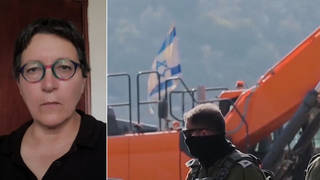
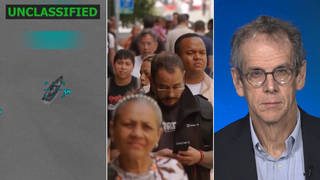
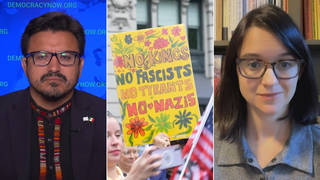
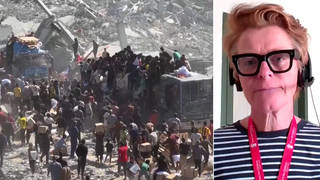





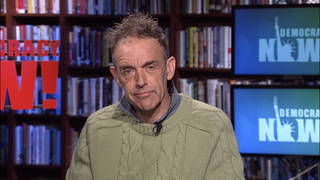

Media Options